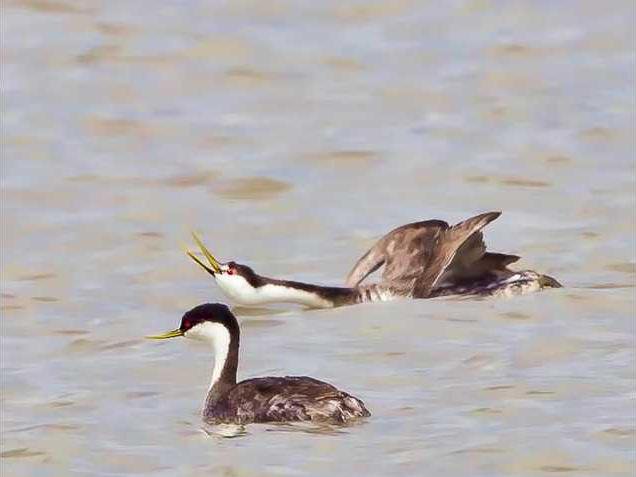Editor’s note: Julie Stielestra is a medical librarian, longtime birder, hiker and fiction writer. She lives part of the year in Chicago, and part of the year in Ellinwood. She is a guest columnist for Marsh Musings.
The first time I ever saw a Western grebe pop up in the water at Cheyenne Bottoms, I thought, what is that? Not quite a duck with that sharp yellow dagger of a bill; too small for a swan, but with a gracefully curved white neck, and a rakish black velvet hat pulled down over ruby-red eyes. What an elegant bird!
Grebes are a very old family of aquatic birds, and five different kinds visit or nest in the Bottoms. It’s both easy and hard to miss a Western grebe: they are the biggest grebes (about the size of a mallard or a pintail) and are easily spotted in open water, but they are skittish and quick. A grebe can compress his thick pelt-like feathers and dive or submerge and disappear in the blink of an eye. You can wait a long time, and then suddenly, there he is again, WAY far out there! They are almost purely water birds: their legs and feet are set so far back on their bodies that they are nearly helpless on land. In the winter, they gather by the thousands and float in huge rafts off the Pacific coast. But in the spring, a few find their way to Kansas and decide to raise their families at the Bottoms. The red-winged blackbirds shrug up their shoulder patches and shrill out their merits to the ladies, frogs sing, avocets do a charming little do-see-do, but no one has a more spectacular display than the Western grebe.
We settled down watch our grebe. Then another one appeared. It dabbled and preened as the first one swam here and there, calling in a high thin voice. The first one followed the second one around, but she ignored him. He circled and called, she noodled around, dove, reappeared. Then he planted himself in front of her and began to bob his head up and down, up and down. She twisted her head side to side, then he did the same. Then, they both ducked and stretched, ducked and stretched, in unison. It was like watching a single grebe in a mirror. They swiveled their heads left and right, back and forth, sometimes in rhythmic alternation, sometimes perfectly synchronized. Side by side, they paddled together a few yards. Suddenly they reared up, exploding up high out of the water, broad white breasts thrust out, and went sprinting across the surface together, necks kinked, heads high, water flying from their milling feet. They went spinning magnificently across the marsh, leaving a sparkling double wake. Then they hurled themselves down into the water again with a splash, she resumed noodling and dabbling while he wandered and cried. Show over.
In the early fall, we spotted a little group of Western grebes. Through the scope, I could just make out a funny little bump on one grebe’s back. Zoom in: a chick! A fuzzy little chick, cozily catching a ride on Mom or Dad’s back. Then the adult stretched up, flung out its wings and gave itself a good full-body shake. One, two, three, FOUR chicks were rudely dumped off their transport into the water. They floundered and bobbed, then scrambled aboard next passing grebe-bus. Shared parenting -we approve.
This is the season for dancing. Keep an eye out for these big handsome grebes and maybe a pair of them will dazzle you with their show.
Marsh Musings
BY JULIE STIELESTRA





